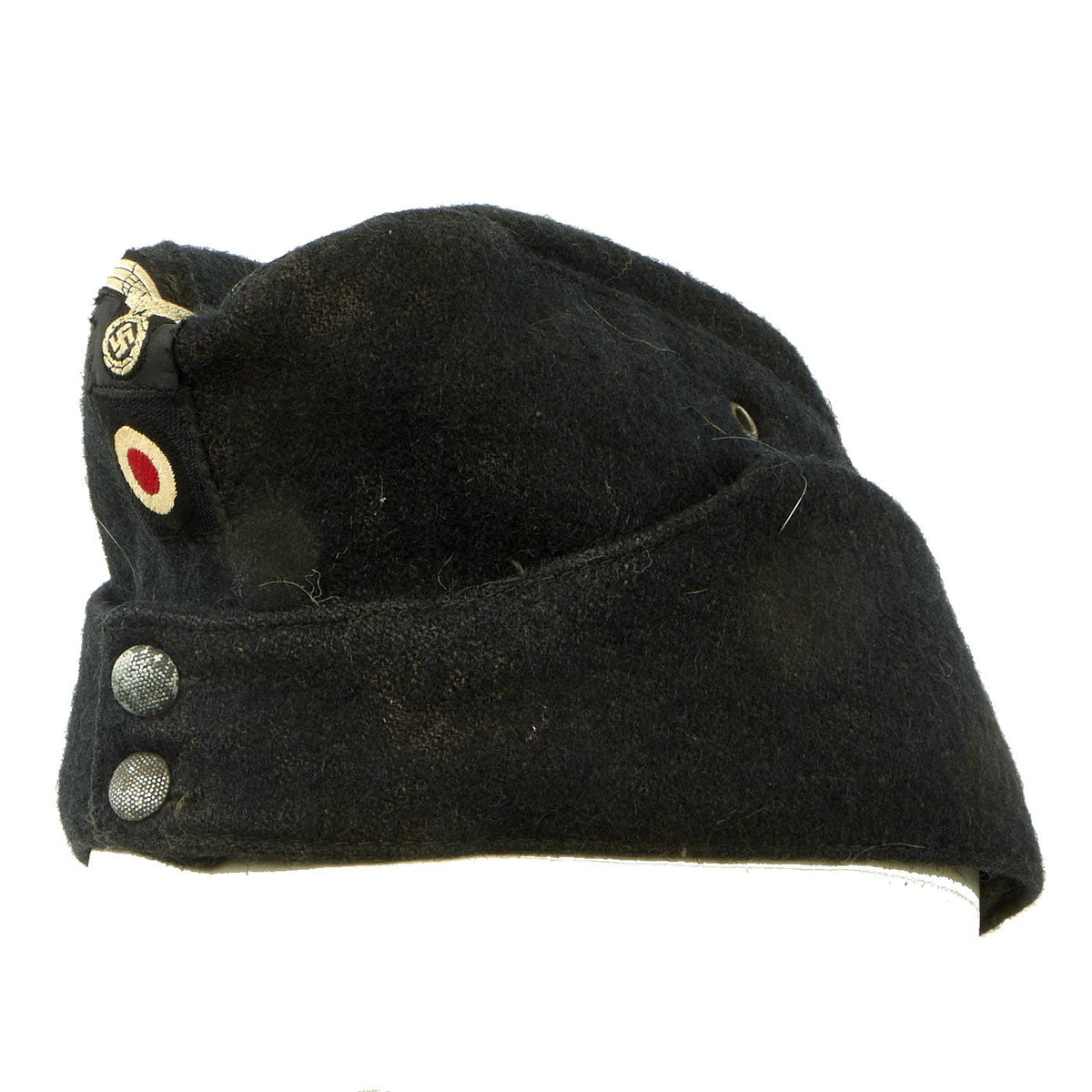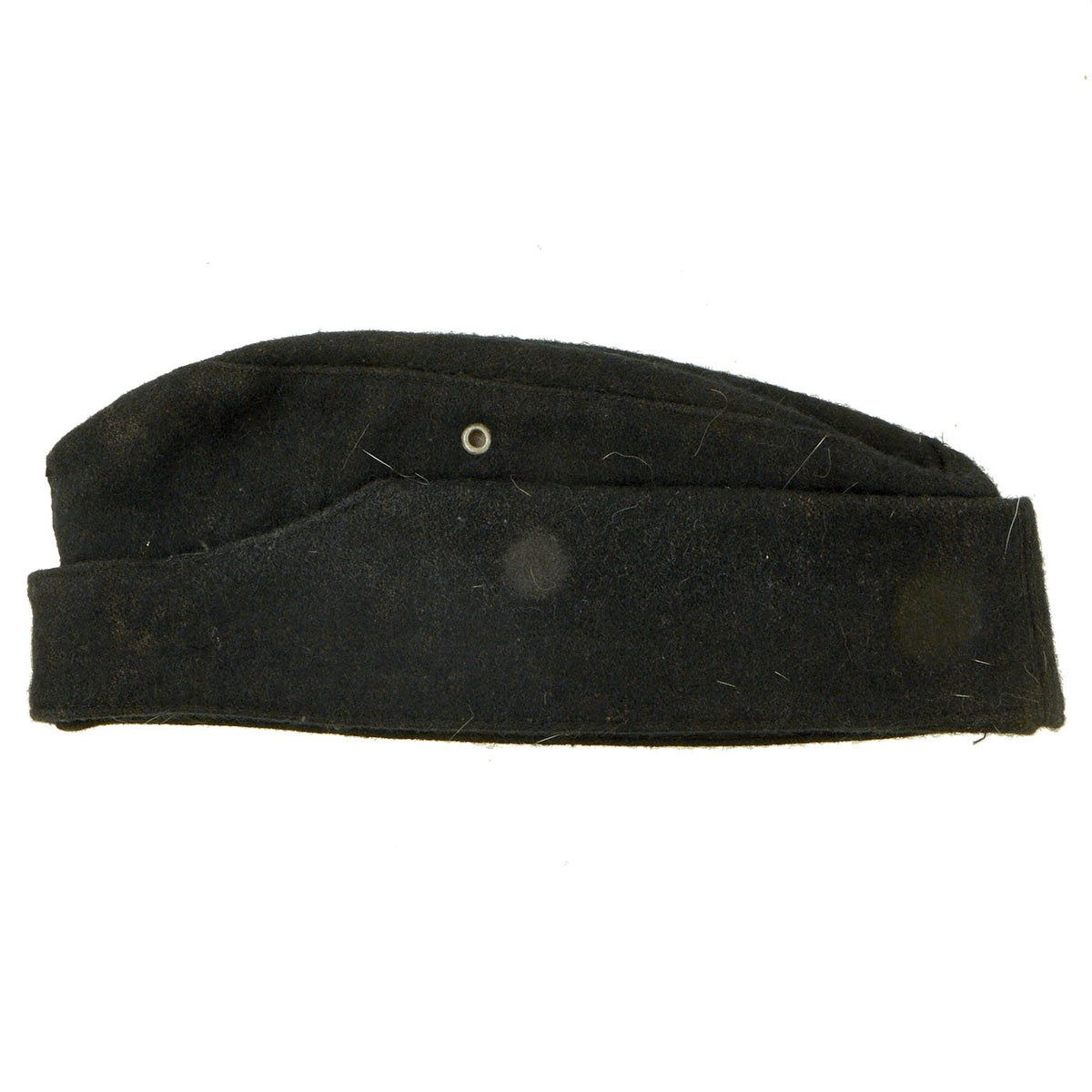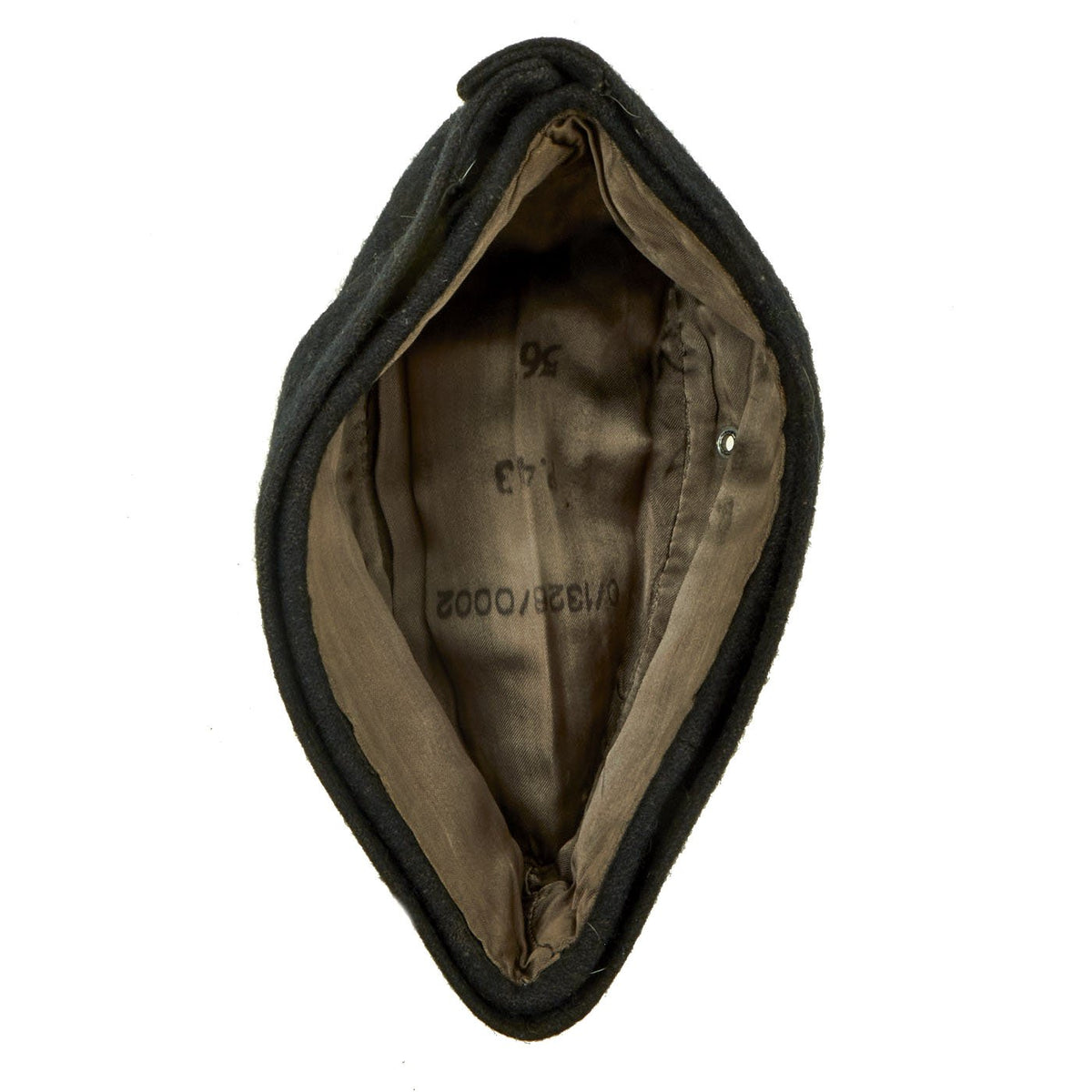Original German WWII 1943 dated Panzer EM-NCO M42 Feldmütze Overseas Cap with RBNr. Marking – size 56 Original Items
$ 1.395,00 $ 348,75
Original Item: Only One Available. This is a very good service used example of a German WWII Heer Panzer EM-NCO M42 overseas or field cap ( Feldmütze). This version bridged the gap between the M38 “Schiffchen” and the later Bergmütze (mountain cap) derived M43 field cap. It has the overall shape of the M38, but the pull-down neck and ear cover from the M43. These are extremely rare, and were not made in any large numbers.
This example is constructed of a black wool exterior for Panzer troops, with a gray rayon lining. It features a fine Panzer BeVo style machine embroidered eagle, with white thread on a black green base, the standard Panzer Field colors. Below this is a machine embroidered bullion National Tri-Color Cockade on a square black. background. There is no piping or soutache, so this was for an enlisted man.
The interior of the cap has a German RBNr. marking, as well as a size and date:
0/1326/0002
P. 43
56
We have done some research, and unfortunately we cannot even find which region “1326” is. There are unfortunately no documents with definitive lists of the RBNr. contracts, so this maker is unfortunately unidentified.
Condition of this cap is very good, with spotted wear to the nap of the outer shell, most likely from moth damage. The front buttons are still intact, and the flaps fold down easily. The interior shows only light service wear, making this a really great example.
Ready to add to your collection!
The M42 overseas cap was introduced for wear by EM/NCO personnel on July 21ST 1942, as a replacement for the earlier M34 overseas cap. The M42 cap was designed to offer more protection from the cold for the ears and neck and the design pattern was based on the Mountain Troopers Bergmütze, (Mountain Cap), but without the visor. After its introduction the M42 overseas cap was worn for the duration of the war although it never fully replaced the M34 overseas caps. The German army originally adopted a slightly modified version of the NSDAP’s national eagle by order on February 17TH 1934, with instructions to have it applied to all steel helmets, visor caps, and tunics by May 1ST 1934. Regulations followed on October 30TH 1935 that stipulated the national eagle was also to be applied to all field caps. On March 14TH 1933 the Weimar Reichswehr era oval black, red and gold cockade was replaced with a circular cockade in black, white, and red and was utilized through-out the Third Reich period.
Reichsbetriebsnummer or RB number (also represented as RB Nr or Rbnr). Before the war, the Germans set up a system for registering and recording the factory information, the Reichsbetriebskartei. This was to help enable machine tabulation of facts and figures. It was from this that the Reichsbetriebsnummer came into being. The Reichsministerium für Rüstung und Kriegsproduktion (Ministry for Armaments and War Production) files survive today in the Bundesarchiv, however, these are only fragmentary. There is a holding file from the working group created by the Office of Machine Reporting in the Armament Office of the Reich Ministry for Armaments and War Production – their main focus was the operations of the industry group for which an economic interest was Armour production. This index provides information on the most important data of the companies covered by it, production profile, operating area, number of employees and the responsible operator.
As a prerequisite for the intended use of the punch-card method in the armaments industry, it was this system which gave rise to the Rbnr. The operating numbers were assigned by the competent local district offices of Machine reporting. (Bezirksstellen des Maschinellen Berichtswesens.) The index is in the form of index cards that are accessible numerically (approximately 14 meters of index cards!). Access to this register is only possible through the naming of this company, stating the place of production. The Reichsministerium für Rüstung und Kriegsproduktion files have multiple entries on the introduction of the factory and also the lot no.
The Rbnr code was used from 1943 onwards and replaced the makers name and address (or company logo) on government contract uniforms, caps and field equipment and knives. It is either rubber ink stamped on cloth or die stamped onto leather & metal items. It has been written countless times that this numeric code system was introduced as a security measure to help mask production locations. This was not the case but it was perhaps, a helpful by- product of the system. It is not unknown to find the Rbnr together with the maker’s info. Had it been a security measure, clearly this practise would have been banned.
So what was the Rbnr? It was a nine digit number and was normally represented thus: RB Nr: 0/000/0000.
The first prefix number could range from 0 through to 9. This number determined the membership of the various groups in the realm of Trade and Industry (Reichsgruppenleitzahl)
• 0 Industry
• 1 Crafts
• 2 Commercial wholesale trading companies
• 3 Banking
• 4 Insurance Companies
• 5 Energy (Electrical companies and such)
• 6 Tourism (Including Hotels, Wine and Mineral Water companies)
• 7 Traffic
• 8 Food Industry
• 9 Not otherwise mentioned groups
Fast Shipping with Professional Packaging
Thanks to our longstanding association with UPS FedEx DHL, and other major international carriers, we are able to provide a range of shipping options. Our warehouse staff is expertly trained and will wrap your products according to our exact and precise specifications. Prior to shipping, your goods will be thoroughly examined and securely secured. We ship to thousands clients each day across multiple countries. This shows how we're dedicated to be the largest retailer on the internet. Warehouses and distribution centres can be located throughout Europe as well as the USA.
Note: Orders with more than one item will be assigned a processing date depending on the item.
Before shipping before shipping, we'll conduct a thorough inspection of the items you have ordered. Today, the majority of orders will be delivered within 48 hours. The delivery time will be between 3-7 days.
Returns
The stock is dynamic and we cannot completely manage it because multiple stakeholders are involved, including our factory and warehouse. So the actual stock may alter at any time. It's possible that you may not receive your order once the order has been made.
Our policy is valid for a period of 30 days. If you don't receive the product within 30 days, we are not able to issue a refund or an exchange.
You can only return an item if it is unused and in the same state as the day you received it. You must have the item in its original packaging.
Related products
Uncategorized
Armoured Fighting Vehicles of the World: AFVs of World War One (Hardcover Book) New Made Items
Uncategorized
Uncategorized
Uncategorized
Uncategorized
Uncategorized
Uncategorized
Uncategorized
Uncategorized
Uncategorized
Uncategorized
Uncategorized
Uncategorized
Uncategorized
Angolan Rebel 1970s era 60mm Inert Display Mortar from Angolan Civil War Original Items
Uncategorized
Uncategorized
Uncategorized
Uncategorized
Armored Burgonet Helmet & Polearm from Scottish Castle Leith Hall Circa 1700 Original Items
Uncategorized
Uncategorized
Uncategorized












































































